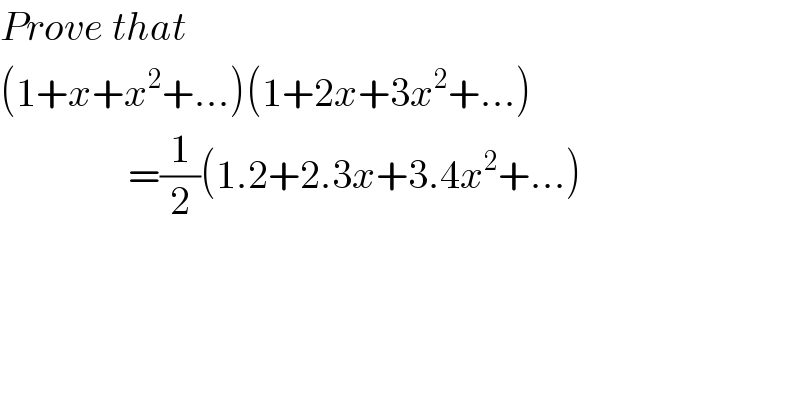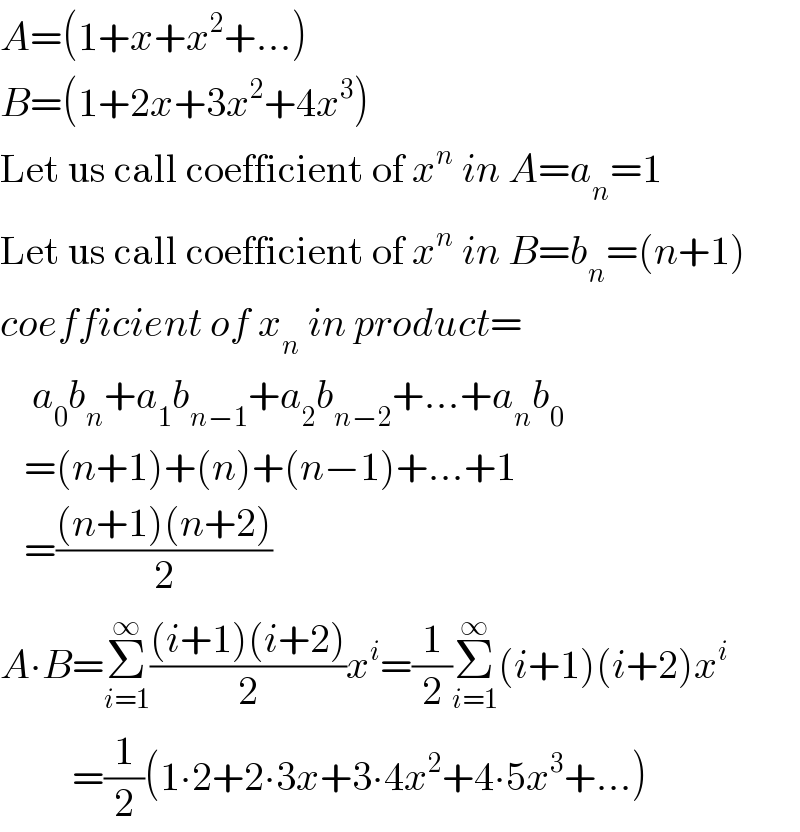Question Number 2795 by Rasheed Soomro last updated on 27/Nov/15

$${Prove}\:{that} \\ $$$$\left(\mathrm{1}+{x}+{x}^{\mathrm{2}} +…\right)\left(\mathrm{1}+\mathrm{2}{x}+\mathrm{3}{x}^{\mathrm{2}} +…\right) \\ $$$$\:\:\:\:\:\:\:\:\:\:\:\:\:\:\:\:=\frac{\mathrm{1}}{\mathrm{2}}\left(\mathrm{1}.\mathrm{2}+\mathrm{2}.\mathrm{3}{x}+\mathrm{3}.\mathrm{4}{x}^{\mathrm{2}} +…\right) \\ $$
Answered by prakash jain last updated on 27/Nov/15

$${A}=\left(\mathrm{1}+{x}+{x}^{\mathrm{2}} +…\right) \\ $$$${B}=\left(\mathrm{1}+\mathrm{2}{x}+\mathrm{3}{x}^{\mathrm{2}} +\mathrm{4}{x}^{\mathrm{3}} \right) \\ $$$$\mathrm{Let}\:\mathrm{us}\:\mathrm{call}\:\mathrm{coefficient}\:\mathrm{of}\:{x}^{{n}} \:{in}\:{A}={a}_{{n}} =\mathrm{1} \\ $$$$\mathrm{Let}\:\mathrm{us}\:\mathrm{call}\:\mathrm{coefficient}\:\mathrm{of}\:{x}^{{n}} \:{in}\:{B}={b}_{{n}} =\left({n}+\mathrm{1}\right) \\ $$$${coefficient}\:{of}\:{x}_{{n}} \:{in}\:{product}= \\ $$$$\:\:\:\:{a}_{\mathrm{0}} {b}_{{n}} +{a}_{\mathrm{1}} {b}_{{n}−\mathrm{1}} +{a}_{\mathrm{2}} {b}_{{n}−\mathrm{2}} +…+{a}_{{n}} {b}_{\mathrm{0}} \\ $$$$\:\:\:=\left({n}+\mathrm{1}\right)+\left({n}\right)+\left({n}−\mathrm{1}\right)+…+\mathrm{1} \\ $$$$\:\:\:=\frac{\left({n}+\mathrm{1}\right)\left({n}+\mathrm{2}\right)}{\mathrm{2}} \\ $$$${A}\centerdot{B}=\underset{{i}=\mathrm{1}} {\overset{\infty} {\sum}}\frac{\left({i}+\mathrm{1}\right)\left({i}+\mathrm{2}\right)}{\mathrm{2}}{x}^{{i}} =\frac{\mathrm{1}}{\mathrm{2}}\underset{{i}=\mathrm{1}} {\overset{\infty} {\sum}}\left({i}+\mathrm{1}\right)\left({i}+\mathrm{2}\right){x}^{{i}} \\ $$$$\:\:\:\:\:\:\:\:\:=\frac{\mathrm{1}}{\mathrm{2}}\left(\mathrm{1}\centerdot\mathrm{2}+\mathrm{2}\centerdot\mathrm{3}{x}+\mathrm{3}\centerdot\mathrm{4}{x}^{\mathrm{2}} +\mathrm{4}\centerdot\mathrm{5}{x}^{\mathrm{3}} +…\right) \\ $$
Answered by Yozzi last updated on 27/Nov/15

$${The}\:{Maclaurin}\:{series}\:{of}\:\frac{\mathrm{1}}{\mathrm{1}−{x}}\:{gives} \\ $$$$\frac{\mathrm{1}}{\mathrm{1}−{x}}=\mathrm{1}+{x}+{x}^{\mathrm{2}} +{x}^{\mathrm{3}} +…=\underset{{r}=\mathrm{0}} {\overset{\infty} {\sum}}{x}^{{r}} \\ $$$$ \\ $$$$\mathrm{PROOF}:\: \\ $$$${Let}\:{f}\left({x}\right)=\frac{\mathrm{1}}{\mathrm{1}−{x}}\:,{x}\in\mathbb{R}−\left\{\mathrm{1}\right\}. \\ $$$${Differentiating}\:{we}\:{get} \\ $$$${f}^{\left(\mathrm{0}\right)} \left({x}\right)=\left(\mathrm{1}−{x}\right)^{−\mathrm{1}} \\ $$$${f}^{\left(\mathrm{1}\right)} \left({x}\right)=\left(\mathrm{1}−{x}\right)^{−\mathrm{2}} \\ $$$${f}^{\left(\mathrm{2}\right)} \left({x}\right)=\mathrm{2}\left(\mathrm{1}−{x}\right)^{−\mathrm{3}} \\ $$$${f}^{\left(\mathrm{3}\right)} \left({x}\right)=\mathrm{6}\left(\mathrm{1}−{x}\right)^{−\mathrm{4}} . \\ $$$${I}\:{conject}\:{that}\:{f}^{\left({n}\right)} \left({x}\right)={n}!\left(\mathrm{1}−{x}\right)^{−{n}−\mathrm{1}} \\ $$$${where}\:{f}^{\left({n}\right)} \left({x}\right)\:{denotes}\:{the}\:{nth}\:{derivative} \\ $$$${of}\:{f}\left({x}\right)=\left(\mathrm{1}−{x}\right)^{−\mathrm{1}} \:\left({x}\neq\mathrm{1}\right)\:{and}\:{n}\in\mathbb{N}\cup\left\{\mathrm{0}\right\}. \\ $$$$ \\ $$$${Let}\:{P}\left({n}\right)\:{be}\:{the}\:{proposition}\:{that}\: \\ $$$$\:\:\:\:\:\:\:\:\:\:{f}^{\left({n}\right)} \left({x}\right)={n}!\left(\mathrm{1}−{x}\right)^{−{n}−\mathrm{1}} \\ $$$${as}\:{conjectured}. \\ $$$${For}\:{n}=\mathrm{0},\:{P}\left(\mathrm{0}\right)\:{gives}\:{f}^{\left(\mathrm{0}\right)} =\mathrm{0}!\left(\mathrm{1}−{x}\right)^{−\mathrm{0}−\mathrm{1}} \\ $$$${f}^{\left(\mathrm{0}\right)} \left({x}\right)=\mathrm{1}×\left(\mathrm{1}−{x}\right)^{−\mathrm{1}} =\left(\mathrm{1}−{x}\right)^{−\mathrm{1}} \\ $$$${which}\:{is}\:{f}\left({x}\right)\:{differentiated}\:{zero}\:{times}. \\ $$$${Therefore},\:{P}\left({n}\right)\:{is}\:{true}\:{when}\:{n}=\mathrm{0}. \\ $$$${Assume}\:{now}\:{that}\:{P}\left({n}\right)\:{is}\:{true}\:{when} \\ $$$${n}={k}:\:\:{f}^{\left({k}\right)} \left({x}\right)={k}!\left(\mathrm{1}−{x}\right)^{−{k}−\mathrm{1}} . \\ $$$${Fot}\:{n}={k}+\mathrm{1}, \\ $$$${f}^{\left({k}+\mathrm{1}\right)} \left({x}\right)=\frac{{d}}{{dx}}\left({f}^{\left({k}\right)} \left({x}\right)\right) \\ $$$$\:\:\:\:\:\:\:\:\:\:\:\:\:\:\:\:\:\:=\frac{{d}}{{dx}}\left({k}!\left(\mathrm{1}−{x}\right)^{−{k}−\mathrm{1}} \right) \\ $$$$\:\:\:\:\:\:\:\:\:\:\:\:\:\:\:\:\:\:=\left(−{k}−\mathrm{1}\right)\left(−\mathrm{1}\right){k}!\left(\mathrm{1}−{x}\right)^{−{k}−\mathrm{2}} \\ $$$$\:\:\:\:\:\:\:\:\:\:\:\:\:\:\:\:\:\:=\left({k}+\mathrm{1}\right){k}!\left(\mathrm{1}−{x}\right)^{−{k}−\mathrm{2}} \\ $$$${f}^{\left({k}+\mathrm{1}\right)} \left({x}\right)=\left({k}+\mathrm{1}\right)!\left(\mathrm{1}−{x}\right)^{−\left({k}+\mathrm{1}\right)−\mathrm{1}} \\ $$$${So},\:{P}\left({k}+\mathrm{1}\right)\:{is}\:{true},\:{assuming}\:{P}\left({k}\right)\:{is} \\ $$$${true}.\:{Since}\:{P}\left(\mathrm{0}\right)\:{is}\:{true}\:{then},{by}\:{the} \\ $$$${principle}\:{of}\:{mathematical}\:{induction}, \\ $$$${P}\left({n}\right)\:{is}\:{true}\:{for}\:{all}\:{non}−{negative}\: \\ $$$${integers}.\: \\ $$$$ \\ $$$${Hence},\:{f}\left({x}\right)\:{is}\:{infinitely}\:{differentiable} \\ $$$${for}\:{x}\neq\mathrm{1}\:{and}\:{f}\left({x}\right)\:{with}\:{all}\:{its}\:{derivatives}\:{are} \\ $$$${defined}\:{at}\:{x}=\mathrm{0}.\:{We}\:{can}\:{then}\:{obtain}\: \\ $$$${the}\:{Maclaurin}\:{series}\:{expansion}\:{of} \\ $$$${f}\left({x}\right)=\frac{\mathrm{1}}{\mathrm{1}−{x}}.\:{This}\:{is}\:{given}\:{by} \\ $$$${f}\left({x}\right)=\underset{{r}=\mathrm{0}} {\overset{\infty} {\sum}}\frac{{x}^{{r}} {f}^{\left({r}\right)} \left(\mathrm{0}\right)}{{r}!} \\ $$$${Since}\:{f}^{\left({r}\right)} \left({x}\right)={r}!\left(\mathrm{1}−{x}\right)^{−{r}−\mathrm{1}} \\ $$$${f}\left({x}\right)=\underset{{r}=\mathrm{0}} {\overset{\infty} {\sum}}\frac{{x}^{{r}} }{{r}!}×{r}!\left(\mathrm{1}−\mathrm{0}\right)^{−{r}−\mathrm{1}} \\ $$$${f}\left({x}\right)=\underset{{r}=\mathrm{0}} {\overset{\infty} {\sum}}{x}^{{r}} \\ $$$${Therefore},\:\frac{\mathrm{1}}{\mathrm{1}−{x}}=\underset{{r}=\mathrm{0}} {\overset{\infty} {\sum}}{x}^{{r}} .\:\:\:\:\:\:\:\:\:\:\:\:\:\:\:\:\:\:\:\:\:\:\:\:\:\:\:\Box \\ $$$$ \\ $$$${Observe}\:{that}\: \\ $$$$\mathrm{1}+\mathrm{2}{x}+\mathrm{3}{x}^{\mathrm{2}} +\mathrm{4}{x}^{\mathrm{3}} +…=\underset{{r}=\mathrm{1}} {\overset{\infty} {\sum}}{rx}^{{r}−\mathrm{1}} \\ $$$${R}.{H}.{S}=\underset{{r}=\mathrm{1}} {\overset{\infty} {\sum}}\frac{{d}}{{dx}}\left({x}^{{r}} \right). \\ $$$${The}\:{series}\:{is}\:{term}\:{by}\:{term}\:{differentiable}. \\ $$$$\therefore\:\underset{{r}=\mathrm{1}} {\overset{\infty} {\sum}}\frac{{d}}{{dx}}\left({x}^{{r}} \right)=\frac{{d}}{{dx}}\left(\underset{{r}=\mathrm{1}} {\overset{\infty} {\sum}}{x}^{{r}} \right)=\frac{{d}}{{dx}}\left({x}\underset{{r}=\mathrm{1}} {\overset{\infty} {\sum}}{x}^{{r}−\mathrm{1}} \right). \\ $$$${Now},\underset{{r}=\mathrm{1}} {\overset{\infty} {\sum}}{x}^{{r}−\mathrm{1}} =\underset{{r}=\mathrm{0}} {\overset{\infty} {\sum}}{x}^{{r}} =\frac{\mathrm{1}}{\mathrm{1}−{x}}. \\ $$$$\therefore{R}.{H}.{S}=\frac{{d}}{{dx}}\left(\frac{{x}}{\mathrm{1}−{x}}\right) \\ $$$$\:\:\:\:\:\:\:\:\:\:\:\:\:\:\:\:=\frac{\left(\mathrm{1}−{x}\right)×\mathrm{1}−\left(−\mathrm{1}\right)\left({x}\right)}{\left(\mathrm{1}−{x}\right)^{\mathrm{2}} }\:\:\left({Quotient}\:{rule}\right) \\ $$$$\:\:\:\:\:\:\:\:\:\:\:\:\:\:\:\:=\frac{\mathrm{1}−{x}+{x}}{\left(\mathrm{1}−{x}\right)^{\mathrm{2}} } \\ $$$${R}.{H}.{S}=\frac{\mathrm{1}}{\left(\mathrm{1}−{x}\right)^{\mathrm{2}} }.\:\therefore\:\underset{{r}=\mathrm{1}} {\overset{\infty} {\sum}}{rx}^{{r}−\mathrm{1}} =\frac{\mathrm{1}}{\left(\mathrm{1}−{x}\right)^{\mathrm{2}} }. \\ $$$${The}\:{L}.{H}.{S}\:{product}\:{of}\:{the}\:{equation} \\ $$$${in}\:{question}\:{becomes} \\ $$$$\left(\underset{{r}=\mathrm{0}} {\overset{\infty} {\sum}}{x}^{{r}} \right)\left(\underset{{r}=\mathrm{1}} {\overset{\infty} {\sum}}{rx}^{{r}−\mathrm{1}} \right)=\frac{\mathrm{1}}{\mathrm{1}−{x}}×\frac{\mathrm{1}}{\left(\mathrm{1}−{x}\right)^{\mathrm{2}} } \\ $$$${L}.{H}.{S}=\frac{\mathrm{1}}{\left(\mathrm{1}−{x}\right)^{\mathrm{3}} }. \\ $$$${Let}\:{g}\left({x}\right)=\left(\mathrm{1}−{x}\right)^{−\mathrm{3}} . \\ $$$${g}^{\left(\mathrm{1}\right)} \left({x}\right)=\mathrm{3}\left(\mathrm{1}−{x}\right)^{−\mathrm{4}} =\frac{\mathrm{3}!}{\mathrm{2}!}\left(\mathrm{1}−{x}\right)^{−\mathrm{4}} \\ $$$${g}^{\left(\mathrm{2}\right)} \left({x}\right)=\mathrm{3}×\mathrm{4}\left(\mathrm{1}−{x}\right)^{−\mathrm{5}} =\frac{\mathrm{4}!}{\mathrm{2}!}\left(\mathrm{1}−{x}\right)^{−\mathrm{5}} \\ $$$${g}^{\left(\mathrm{3}\right)} \left({x}\right)=\mathrm{3}×\mathrm{4}×\mathrm{5}\left(\mathrm{1}−{x}\right)^{−\mathrm{6}} =\frac{\mathrm{5}!}{\mathrm{2}!}\left(\mathrm{1}−{x}\right)^{−\mathrm{6}} \\ $$$${I}\:{thus}\:{state}\:{without}\:{proof}\:\:{that}\:{the}\:{nth}\:{derivative} \\ $$
Commented by Yozzi last updated on 27/Nov/15

$${I}\:{ran}\:{out}\:{of}\:{space}… \\ $$
